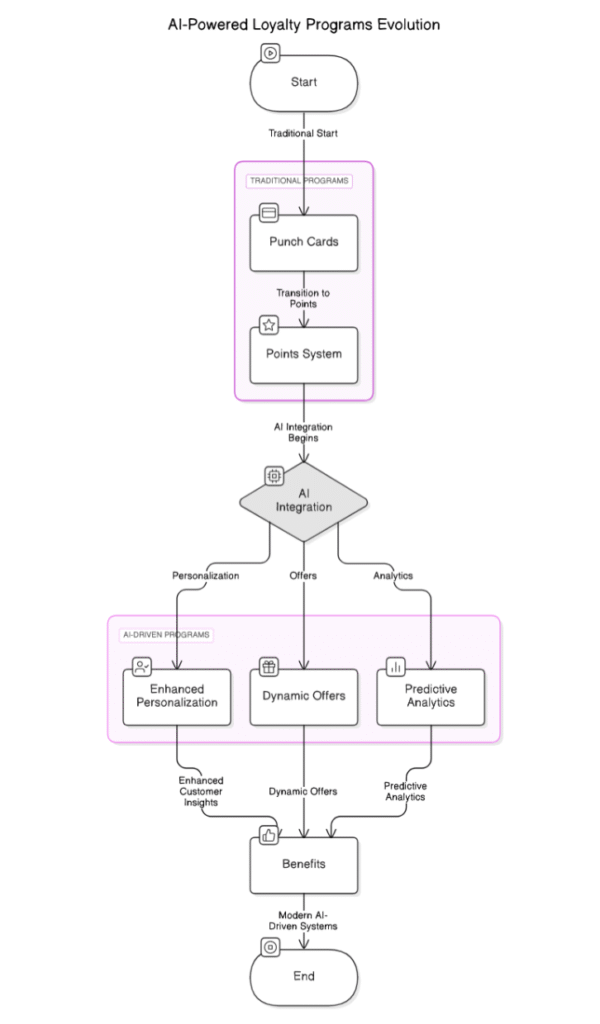Loyalty programs have evolved from basic punch cards and stamps to sophisticated platforms offering points, tiers, and exclusive benefits. Digital technology further transformed these programs, enabling businesses to effectively track customer behavior and preferences. Customers now expect highly personalized content and offers further changing the loyalty program landscape; the integration of AI marks the next significant step in this evolution.
Refer to the image for a visual representation of the concepts discussed in the introduction to AI-powered loyalty programs:1

AI is revolutionizing loyalty program management by enabling continuous optimization, ensuring programs remain effective and engaging. Through dynamic program optimization, machine learning algorithms continuously analyze program performance, identifying which incentives resonate most with customers and drive the highest engagement. AI examines data such as reward redemption rates, customer feedback, and participation trends in timing, demographic and psychographic data. It can pinpoint what works—and what doesn’t—allowing businesses to make data-driven adjustments that enhance both customer satisfaction and program ROI. AI not only streamlines the process but also makes it scalable, allowing businesses to tailor rewards at an individual level, even across large datasets.2
For example, AI might identify that bonus points for specific product categories generate more engagement than blanket discounts or that time-limited challenges boost activity among a younger demographic. This is something that would take days, weeks, or even months to determine using traditional analytic processes. But with machine learning, businesses can now do this “on the fly”, dynamically updating their loyalty programs, offering incentives that are tailored to specific customer segments along with their preferences and market trends.
In Epsilon research on consumer loyalty, 55% of consumer respondents said customized offerings and products were most likely to make them feel good about continuing to participate in a loyalty program, while 44% said it was special recognition—like birthday rewards. There’s nothing more frustrating for a loyal customer than joining a brand’s program, only to receive the same generalized messages as everyone else.3
This adaptive approach ensures that resources are allocated effectively, rewarding customers in ways that are both meaningful to them and profitable for the business. An example of this type of Loyalty AI use in real-life would be Walmart, with an in-house AI platform (built with Walmart Labs), and other platforms (AI and loyalty) layered on top, Walmart is able to use AI for behavioral targeting, predictive replenishment and dynamic couponing.
Loyalty platforms also have AI built-in to help loyalty program managers build campaigns to the size audience they are looking to target, and they are able to do this in basic language without needing to worry about code. Between AI constantly analyzing the data and platforms having ways for marketers to adjust who they are targeting easily, the entire loyalty marketing strategy and execution has changed for the better with so much improvement on dynamic offers and personalization.
AI’s ability to continuously learn and adapt ensures loyalty program marketing remains relevant in an ever-changing marketplace. By leveraging dynamic program optimization, businesses can not only maximize ROI but also build deeper, more rewarding relationships with their customers, ensuring long-term loyalty and competitive advantage.
- AI Agent Loyalty Program Personalization Engine: https://www.rapidinnovation.io/post/ai-agent-loyalty-program-personalization-engine
- How AI Makes Reward Personalization Smarter in Loyalty Programs: https://blog.usetada.com/en/how-ai-makes-reward-personalization-smarter-in-loyalty-programs
- Boost your loyalty marketing efficiency with AI-powered strategy: https://www.epsilon.com/us/insights/blog/boost-loyalty-efficiency-with-ai















